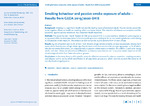Smoking behaviour and passive smoke exposure of adults – Results from GEDA 2019/2020-EHIS
Starker, Anne
Kuhnert, Ronny
Hoebel, Jens
Richter, Almut
Background: Smoking is a significant health risk and the leading cause of premature death. Passive smoke causes the same negative effects on health as smoking, albeit to a lesser extent. The reduction of tobacco consumption and the protection against passive smoke are thus important health objectives.
Methods: The study German Health Update (GEDA 2019/2020-EHIS) is a cross-sectional telephone survey (04/2019 to 09/2020) of the resident population in Germany with questions relating to the current smoking behaviour and relating to the passive smoke exposure. The analysis sample comprises 22,708 persons from 18 years of age.
Results: 24.0% of women and 33.9% of men from 18 years of age smoke currently, at least occasionally. Among both sexes, adults from 65 years of age smoke significantly more rarely than adults in the younger age groups. 4.1% of adults, who do not smoke themselves, are subjected daily to passive smoke exposure indoors. This affects in particular young adults and men. There are educational differences in tobacco consumption and in passive smoke exposure to the disadvantage of adults from lower educational groups.
Conclusions: In Germany, there is still a need for action for effective measures for tobacco prevention, smoking cessation and tobacco control policy, which are effective in all population groups and which take into account the concerns of socially disadvantaged groups.
Files in this item

